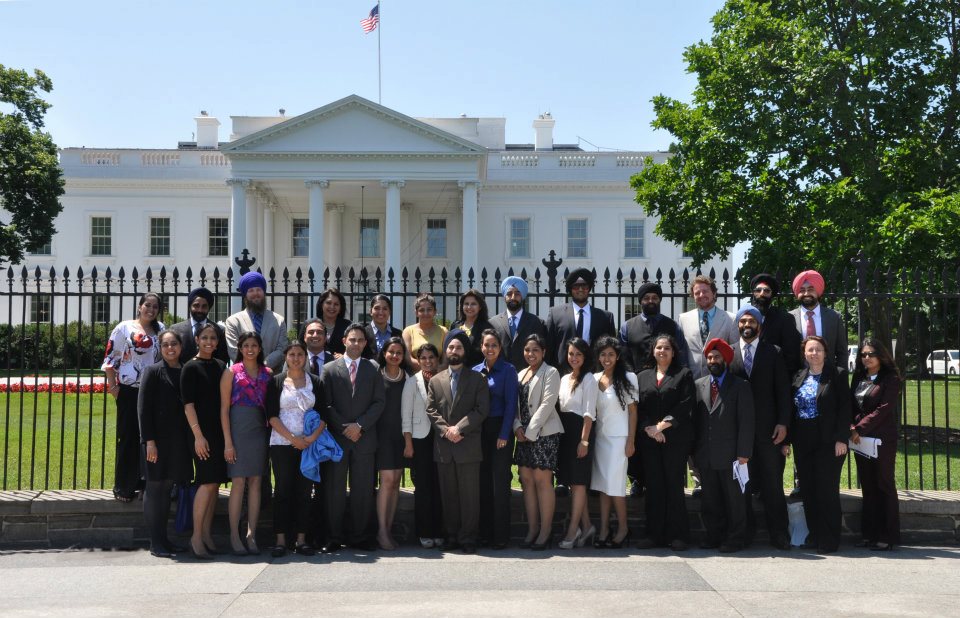
Sikhs in the White House
Co-blogged by Sundari and American Turban
Likely unbeknownst to many Sikhs, last Friday marked a historic moment for America’s Sikh community.
Around 7:30am on that day, about 50 people representing Sikh communities from across the country – California, Texas, Indiana, Ohio, Michigan, Georgia, New York, New Jersey – gathered at the East Wing for a special tour of the White House. These members of the community walked through the historic center of the country, seeing with their own eyes notable places such as the room in which President Thomas Jefferson first held cabinet meetings and the Blue Room which remains the reception room of the White House. Following the tour, community members joined White House administrators for the first-ever White House briefing on Sikh civil rights issues.
For those of us in the audience, it was a deeply moving moment – particularly when the briefing started out with Bole So Nihaal, Sat Sri Akal. Yes, a jakara in the White House!
There was something symbolic in that moment. Once, a long time ago, Sikhs would have made the jakara call while raising their flag at the Red Fort in Delhi, the symbolic capital of India, as Jassa Singh Ahluwalia was proclaimed Sultan-e-Quam (‘king of the nation’) – a gesture in which Sikhs laid claim to their sovereignty as a people in 19th century India. Now, under certainly different circumstances in a land separated by time and distance, Sikhs were making a similar call to claim to their legitimacy as Americans.
The historic briefing was organized by the Sikh Coalition in collaboration with the White House Initiative on Asian Americans and Pacific Islanders and the White House Office of Public Engagement. The event was clearly a testament to the relationships that have been cultivated by the Sikh Coalition and leaders within the community. Read more about the event here.
Certainly, this was not the first time that Sikhs have been in the White House. The Prime Minister of India, Manmohan Singh, was the first State guest of President Obama’s administration in 2009 [Prime Minister Singh also visited the White House in 2005 during President Bush’s term]. Earlier this year, one Navroop Singh Mitter, wearing a bright pink dastar no less, was seen standing behind President Obama during a speech, the photo of which went viral across social media. In 2001, several Sikhs were invited to the White House during the George W. Bush presidency to discuss with the President the safety of Sikhs in the aftermath of the 9/11 attacks.
That event in 2001 was an important moment, however since that visit, there has been no formal engagement of the broader American Sikh community by the White House despite the significant challenges that Sikhs in the country have faced particularly since the fateful day of 9/11. Hate crimes, school bullying, racial profiling, and workplace discrimination have plagued the Sikh community before and after 2001. On Friday, this changed.
As often as Sikhs feel alienated in this country, it was a sight to behold as this large group of Sikhs – women and men, adults and children – made their way through the White House during their tour alongside other Americans. Today, they were Sikhs and they were Americans.
This was further emphasized by the first briefing on Sikh civil rights issues by various organizations within the American government – the Office for Civil Rights at the Department of Education, the Transportation Security Administration (TSA), the Equal Employment Opportunity Commission, the White House Initiative on Asian Americans and Pacific Islanders and the White House Office of Public Engagement. These government agencies reported on their initiatives as they related to Sikh Americans, and answered questions highlighting civil rights concerns related to the Sikh American community. In essence, the briefing was a gesture by the White House that the concerns of the Sikh American community were legitimate and the government was engaging Sikhs in dialogue.
This was a significant step for Sikhs in this country.
As another fellow blogger who also attended the event, writes:
While walking through the East Wing of the White House, I began to recite the mool mantar under my breath with hopes that it will not be the last time these walls hear the Guru’s words. Perhaps, years from now, a Sikh will be walking down this same corridor reciting the same mool mantar surrounded by secret service and staff on their way to meet heads of state or to make a speech to inspire the nation.
While last Friday’s event itself was historic, the potential for what an event like this holds is even more notable.















[…] excerpt above is from a post I co-wrote with blogger Sundari over at the blog The Langar Hall in which we reflect on the significance of this event. You can […]
Bole So Nihal… Sat Sri Akal!
There is no end for Sikhs to reach…….no apex….always shooting high and higher.
Acquisition of the knowledge has undergone through the different and variant aspects. The knowledge is produced and analyzed for the accentuation of the biter and effective manners. The methods of the students are extremely helpful and assistive. The knowledge is employed for the better and accurate methods.